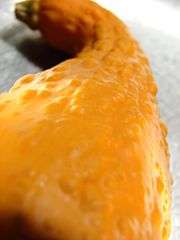Crookneck squash
| Cucurbita pepo 'Yellow crookneck' | |
|---|---|
 Crookneck squash along with other types of squash | |
| Species | Cucurbita pepo |
| Cultivar | Yellow crookneck |
| Origin | Eastern North America |
| Nutritional value per 100 g (3.5 oz) | |
|---|---|
| Energy | 19 kcal (79 kJ) |
|
3.9 g | |
| Dietary fiber | 1.0 g |
|
0.3 g | |
|
1.0 g | |
| Vitamins | |
| Riboflavin (B2) |
(3%) 0.04 mg |
| Vitamin C |
(23%) 19 mg |
| Minerals | |
| Potassium |
(5%) 222 mg |
| Other constituents | |
| Water | 94 g |
| |
|
Percentages are roughly approximated using US recommendations for adults. Source: USDA Nutrient Database | |
Crookneck squash is a cultivar of Cucurbita pepo,[1] the species that also includes some pumpkins and most other summer squashes. The plants are bushy[1] and do not spread like the plants of winter squash and pumpkin.[2] Most often used as a summer squash, it is characterized by its yellow skin (which may be smooth or bumpy)[2] and sweet yellow flesh, as well as its distinctive curved stem-end or "crooked neck".[3] It should not be confused with crookneck cultivars of Cucurbita moschata, such as the winter squash 'Golden Cushaw',[4] or the vining summer squash 'Tromboncino'.[1] Its name distinguishes it from another similar-looking variety of C. pepo, the straightneck squash, which is also usually yellow.[5][6][7] There is one similar non-edible C. pepo variety: C. pepo var. ovifera.[8]
Yellow crookneck squash are generally harvested immature, when they are less than two inches in diameter,[2][3] since the skin toughens and the quality degrades as the squash reaches full maturity.[9]
References
- 1 2 3 "Zucchetta". Mount Vernon Northwestern Washington Research and Extension Center: Vegetable Research and Extension. Washington State University. Retrieved 10 May 2013.
- 1 2 3 "Summer Squash". Watch Your Garden Grow. University of Illinois Extension. Retrieved 14 May 2013.
- 1 2 "Summer Squash" (PDF). University of the District of Columbia Cooperative Extension Service. Retrieved 14 May 2013.
- ↑ Phillips, R.; Rix, M. (1993). Vegetables. New York: Random House.
- ↑ Saade, R. Lira; Hernández, S. Montes. "Cucurbits". Purdue Horticulture. Retrieved September 2, 2013.
- ↑ "Cucurbita pepo". Missouri Botanical Garden. Retrieved September 2, 2013.
- ↑ Heistinger, Andrea (2013). The Manual of Seed Saving: Harvesting, Storing, and Sowing Techniques for Vegetables, Herbs, and Fruits. Portland, OR: Timber Press. p. 278. ISBN 978-1-60469-382-9.
- ↑ Decker, Deena S.; Wilson, Hugh D. (1987). "Allozyme Variation in the Cucurbita pepo Complex: C. pepo var. ovifera vs. C. texana". Systematic Botany. American Society of Plant Taxonomists. 12 (2): 263–273. doi:10.2307/2419320. JSTOR 2419320.
- ↑ "Summer and Winter Squash". Utah State University Cooperative Extension. Retrieved 14 May 2013.
External links

| Wikimedia Commons has media related to Crookneck squash. |
